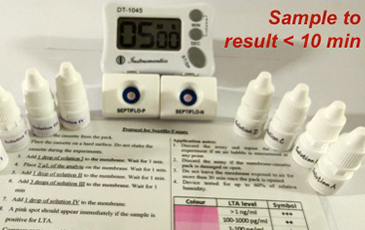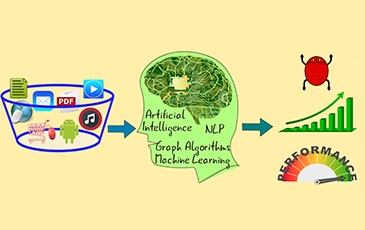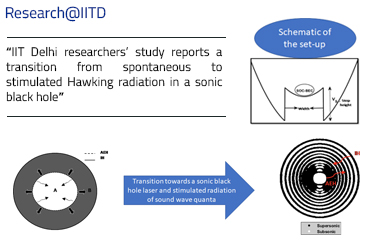Analogue Gravity or its breakdown - Transition from Spontaneous to Stimulated Hawking Radiation
Share this on

In a recent paper published in Physical Review A, Atomic Moleculer Optical Physics and Quantum information’s one of the top journals, published by American Physical Society, researchers from IIT Delhi reports a transition from spontaneous Hawking radiation in sonic black hole to stimulated Hawking radiation in a sonic black hole laser. Sonic analogue of black hole ( SBH) traps sound within a single acoustic event horizon (AEH), and, emits spontaneous sonic Hawking radiation (HR), a feat experimentally observed by Israeli experimentalist J. Steinhauer in 2016, when he was testing the idea first espoused by Bill Unruh to explain how Stephen Hawking’s famous prediction can be seen in a table-top experiment.
A sonic black hole laser allows that sound to go back and forth between two such event horizons ( inner (IH) and outer (AEH)), resulting in a stimulated Hawking radiation, theoretically proposed first by Corley and Jacobson. This was also observed by Steinhauer in 2014. By simulating the time evolution of spin-orbit coupled Bose-Einstein condensate (SOC-BEC) of ultra-cold atoms in a ring-shaped laser-induced potential, Inderpreet Kaur et. al. have been able to detect a clear transition from such spontaneous HR in a SBH to stimulated HR in SBHL, and, show how the radiation in stimulated HR deviates from the Planck's formula of black-body radiation of a featureless thermal radiation. They figured out that spin-orbit coupling strongly impacts the analogue Hawking radiation that comes from such two-dimensional SBH, and, provides new insight to the validity of gravitational -analogy that relates the sonic black holes to their gravitational counterparts.
“Such a clear transition from spontaneous to stimulated analogue Hawking radiation in the ultra-cold atomic condensate, the breakdown of the gravitational analogy at later time and the demonstration of the deviation from the thermality condition provides important insights to the possible use of such an analogue model to study the fundamental issues such as information paradox related to real black holes”, says Ghosh, who is a professor in the physics department, IIT Delhi, and, whose group has been studying theoretically the properties of ultra-cold atomic condensate for quite some time. This work is supported by a five year project, funded by BRNS, Department of Atomic Energy, Govt of India.
Science X, the network that covers the interesting research from science, technology and medical world, published a dialogue based story by the authors explaining the exotic physics that this work reports https://sciencex.com/news/2020-07-transition-spontaneous-hawking-sonic-black.html
The work has been published in Physical Review A (by American Physical Society), Physical Review A, 102, 023314 (2020)
URL: https://link.aps.org/doi/10.1103/PhysRevA.102.023314
DOI: 10.1103/PhysRevA.102.023314




